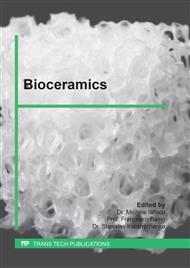p.47
p.53
p.59
p.65
p.71
p.77
p.83
p.91
p.97
In Vitro Resorbability of 3D Printed Hydroxyapatite in Two Different pH Buffered Solutions
Abstract:
Resorability of 3D printed hydroxyapatite (3DP HA) in deionized water solution which was buffered with succinic acid-NaOH (pH 5.5) and Tris(hydroxymethyl aminomethane) (pH 7.4) for 1, 7, 14 and 28 days was carried out. Weight change and release of calcium (Ca) and phosphorus (P) were used to evaluate the sample resorption. It was found that the weight of samples soaking in both pH 5.5 and 7.4 solutions decreased with increasing soaking times, but the degree of decrease was greater at pH 5.5 than at pH 7.4. ICP-OES results showed that the release of Ca and P in both pH solutions increased with immersing times. The amount of Ca and P released at pH 5.5 was higher than at pH 7.4. Phase composition of the samples and the microstructure of the sample were characterized using XRD and SEM respectively. XRD analysis showed that hydroxyapatite (HA) and octacalcium phosphate (OCP) phases were found at the center of all samples, but the intensity of OCP peaks tended to decrease with increasing times. Only HA was found on the sample surface after immersion in both pH solutions at all soaking periods. After immersion, newly formed crystals were seen both at the center and/or on the surface of samples. These results suggested that pH could influence the resorption of the samples and also the formation of new calcium phosphate crystals.
Info:
Periodical:
Pages:
71-76
Citation:
Online since:
April 2019
Keywords:
Price:
Сopyright:
© 2019 Trans Tech Publications Ltd. All Rights Reserved
Share:
Citation:



